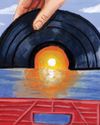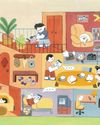
IN THE ’90S, when he was a doc toral student at the University of Lausanne, in Switzerland, neuro scientist Sean Hill spent five years studying how cat brains respond to noise. At the time, researchers knew that two regions — the cerebral cortex, which is the outer layer of the brain, and the thalamus, a nutlike structure near the centre did most of the work. But, when an auditory signal entered the brain through the ear, what happened, specifically? Which parts of the cortex and thalamus did the signal travel to? And in what order? The answers to such questions could help doc tors treat hearing loss in humans. So, to learn more, Hill, along with his super visor and a group of lab techs, anaesthetized cats and inserted electrodes into their brains to monitor what happened when the animals were exposed to sounds, which were piped into their ears via miniature headphones. Hill’s probe then captured the brain signals the noises generated.
The last step was to euthanize the cats and dissect their brains, which was the only way for Hill to verify where he’d put his probes. It was not a part of the study he enjoyed. He’d grown up on a family farm in Maine and had developed a reverence for all sentient life. As an under graduate student in New Hampshire, he’d experimented on pond snails, but only after ensuring that each was properly anaesthetized. “I particularly loved cats,” he says, “but I also deeply believed in the need for animal data.” (For obvious rea sons, neuroscientists cannot euthanize and dissect human subjects.)
This story is from the June 2021 edition of The Walrus.
Start your 7-day Magzter GOLD free trial to access thousands of curated premium stories, and 8,500+ magazines and newspapers.
Already a subscriber ? Sign In
This story is from the June 2021 edition of The Walrus.
Start your 7-day Magzter GOLD free trial to access thousands of curated premium stories, and 8,500+ magazines and newspapers.
Already a subscriber? Sign In

Invisible Lives
Without immigration status, Canada's undocumented youth stay in the shadows

My Guilty Pleasure
"The late nights are mine alone, and I'll spend them however I damn well please"

Vaclav Smil Is Fed Up
The acclaimed environmental scientist is criticizing climate activists, shunning media, and stepping back just when we need him most

It's Time for a Birth Control Revolution
What the pill teaches us about the failure - and future - of women's health care

Would You Watch a Play about Hydro Electricity?
How documentary theatre struck a chord in Quebec

Still Spinning
One record chain has bet big on a new appetite for physical media

Just So You Know, I Love My Mother
In many ways, multi-generational living makes sense. But that doesn't make it easy

Art of the Steal
Why are plundered African artifacts still in Western museums?

Canada in the Middle
What role can we play in easing the war in Gaza?
Canadian Multiculturalism: A Work in Progress
As we mark fifty years since the adoption of Canada’s federal multiculturalism policy, human rights advocate AMIRA ELGHAWABY celebrates its merits and reflects on the work that is yet to be done when it comes to inclusion, acceptance, and fighting systemic racism in our country.